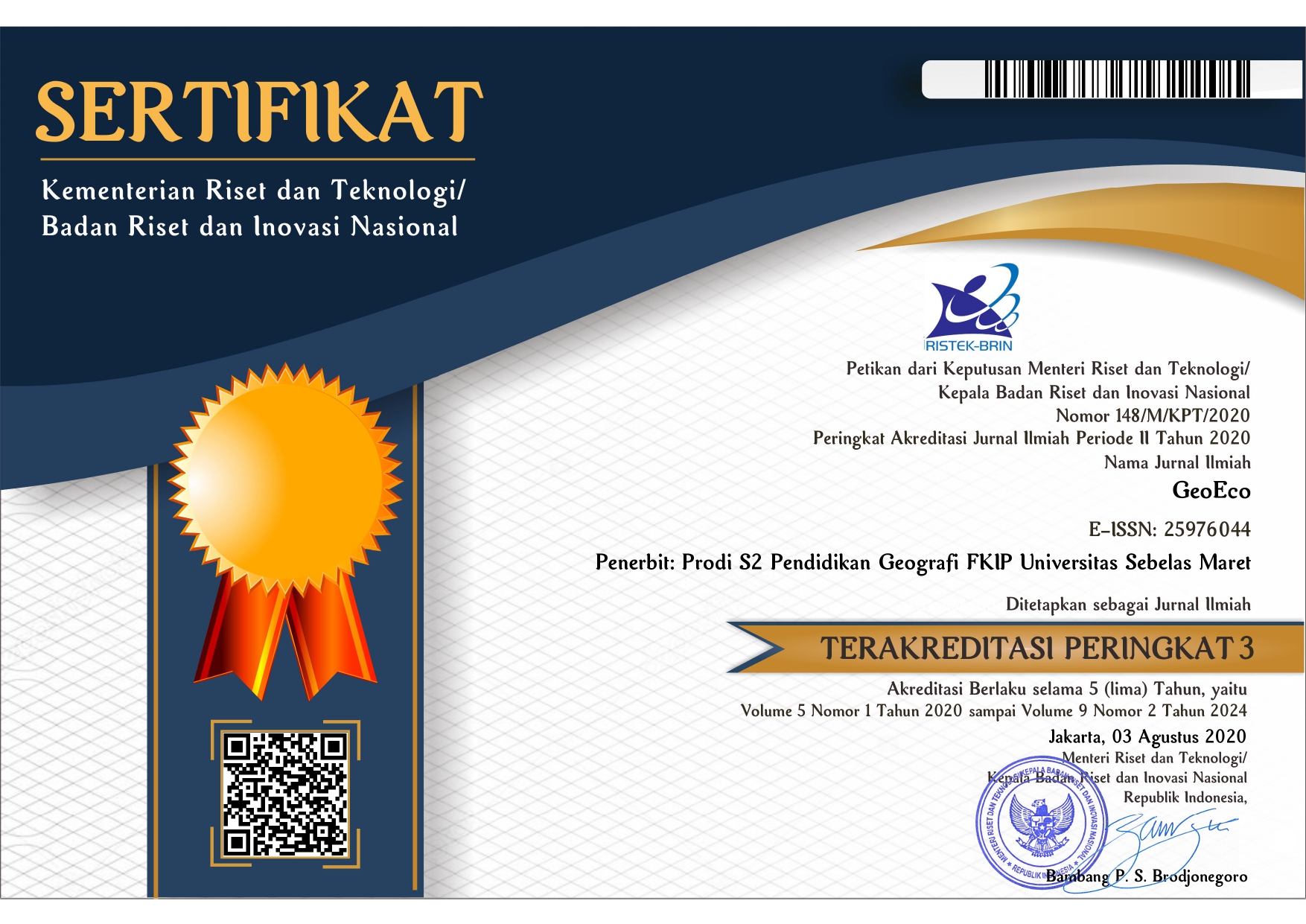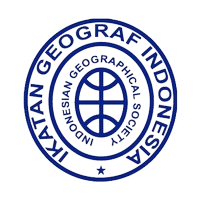CROSS-BORDER FLOOD MANAGEMENT IN BENGAWAN SOLO HULU WATERSHED
Abstract
Cross-border floods are not only cross-country and cross-province floods but also include cross-district/city floods. The flood that occurred in Sukoharjo Regency was a cross-border flood (cross-border flood) covering four upstream districts, namely Boyolali, Klaten, Wonogiri and Karangnanyar Regencies. The management needed concerning cross-border flooding is the handling of integrated cross-border synergies that enter the Watershed (DAS) with countermeasures, not only structural but non-structural, and involving all stakeholders. This study uses a combination of spatial science and critical human geography paradigms so that the appropriate research design is a mixed method, namely research with both quantitative and qualitative techniques. The critical human geography paradigm is also used here in conjunction with the political ecology approach in tracing the increased risk of flood disasters associated with an expanded urbanization process, an approach derived from production space theory. The results of this study show that the integration of disaster management between regions is very important, both upstream and downstream. Human activities in the upstream region greatly affect the downstream region
Keywords
Full Text:
PDFReferences
Booth, L., & Patt, A. (2018). The push for proactive climate adaptation in Europe. Current History, 117(797), 108–113. https://doi.org/10.1525/curh.2018.117.797.108
Boyle, M. S. (2017). Performance and Value: The Work of Theatre in Karl Marx’s Critique of Political Economy. Theatre Survey, 58(1), 3–23. https://doi.org/10.1017/S0040557416000661
Chang, C.-T., & Leentvaar, J. (2008). Risk trading in trans-boundary flood management: case study of the Dutch and German Rhine. Journal of Flood Risk Management, 1(3), 133–141. https://doi.org/10.1111/j.1753-318x.2008.00015.x
Chang, C. T. (2017). Risk-trading in flood management: An economic model. Journal of Environmental Management, 200, 1–5. https://doi.org/10.1016/j.jenvman.2017.05.059
D. Maulidatuz, I. Rini, R. Alfiah, and S. H. (2016). Social Capital On Water Resource Management Case Study Community Involvement on Rural Wellspring Handling in Sumberawan Hamlet of Malang Regency Indonesia. https://doi.org/doi: 10.15224/978-1-63248-111-5-32.
Dasgupta, P. (2015). Critical Challenges : Rebuilding Community Through Social Capital In Watershed Management. 3(5), 9–15.
El-Naqa, A., & Jaber, M. (2018). Floodplain Analysis using ArcGIS, HEC-GeoRAS and HEC-RAS in Attarat Um Al-Ghudran Oil Shale Concession Area, Jordan. Journal of Civil & Environmental Engineering, 08(05). https://doi.org/10.4172/2165-784x.1000323
Gorelick, N., Hancher, M., Dixon, M., Ilyushchenko, S., Thau, D., & Moore, R. (2017). Google Earth Engine: Planetary-scale geospatial analysis for everyone. Remote Sensing of Environment, 202(2016), 18–27. https://doi.org/10.1016/j.rse.2017.06.031
Gotham, K. F. (2013). Tourism gentrification: The case of New Orleans’ vieux carre (french quarter). The Gentrification Debates, 42(7), 145–176. https://doi.org/10.4324/9781315881096
Kundzewicz, Z. W., Hegger, D. L. T., Matczak, P., & Driessen, P. P. J. (2018). Flood-risk reduction: Structural measures and diverse strategies. Proceedings of the National Academy of Sciences of the United States of America, 115(49), 12321–12325. https://doi.org/10.1073/pnas.1818227115
Kusbiantoroa, A. (2016). ocial Capital Role in Solving Land Degradation in Tulis Watershed.
N. Parlinah, B. Nugroho, M. B. Saleh, and H. (2018). Possibility of harnessing social capital to support the development of payment for environmental services in small-scale forests: A case of jatigede catchment area. J. Manaj. Hutan Trop, 24(2), 70–80. https://doi.org/doi: 10.7226/jtfm.24.2.70.
Sneddon, C., & Fox, C. (2006). Rethinking transboundary waters: A critical hydropolitics of the Mekong basin. Political Geography, 25(2), 181–202. https://doi.org/10.1016/j.polgeo.2005.11.002
Soemari, Y. B., Sapri, Maghfiroh, F., Yuniarti, Achaditani, N. M., Variani, R., Tsabitah, A. F., Zulkarnain, A. K., Wahyuningsih, M. S. H., Nugrahaningsih, D. A. A., Akmaliyah, M., Syamsul, E. S., Amanda, N. A., Lestari, D., 2021, scmidt iotc, Sumule, A., Kuncahyo, I., Leviana, F., Xue-, W., Kimia, J. T., … Jubaidah, S. (2020). ANALISIS PENYEBAB BANJIR DI DKI JAKARTA. Journal of Chemical Information and Modeling, 2(1), 5–7. http://jurnal.globalhealthsciencegroup.com/index.php/JPPP/article/download/83/65%0Ahttp://www.embase.com/search/results?subaction=viewrecord&from=export&id=L603546864%5Cnhttp://dx.doi.org/10.1155/2015/420723%0Ahttp://link.springer.com/10.1007/978-3-319-76
Sudmeier-Rieux, K., Fra.Paleo, U., Garschagen, M., Estrella, M., Renaud, F. G., & Jaboyedoff, M. (2015). Opportunities, incentives and challenges to risk sensitive land use planning: Lessons from Nepal, Spain and Vietnam. International Journal of Disaster Risk Reduction, 14, 205–224. https://doi.org/10.1016/j.ijdrr.2014.09.009
Timmerman, J., Matthews, J., Koeppel, S., Valensuela, D., & Vlaanderen, N. (2017). Improving governance in transboundary cooperation in water and climate change adaptation. Water Policy, 19(6), 1014–1029. https://doi.org/10.2166/wp.2017.156
Tri Prayoga, I. N. (2013). Keberlangsungan Menetap Penduduk Asli pada Kawasan di Sekitar Kampus UNDIP Tembalang sebagai Permukiman Kota Semarang yang Tergentrifikasi. Jurnal Pembangunan Wilayah & Kota, 9(1), 1. https://doi.org/10.14710/pwk.v9i1.6499
van Doorn-Hoekveld, W. (2017). Transboundary flood risk management: Compatibilities of the legal systems of flood risk management in the Netherlands, Flanders and France - a comparison. European Energy and Environmental Law Review, 26(3), 81–96. https://doi.org/10.54648/eelr2017010
Refbacks
- There are currently no refbacks.












.png)

